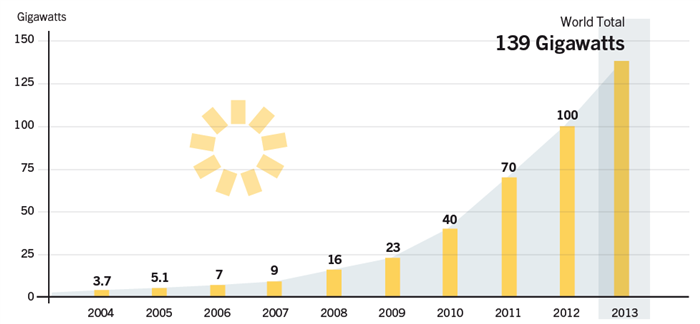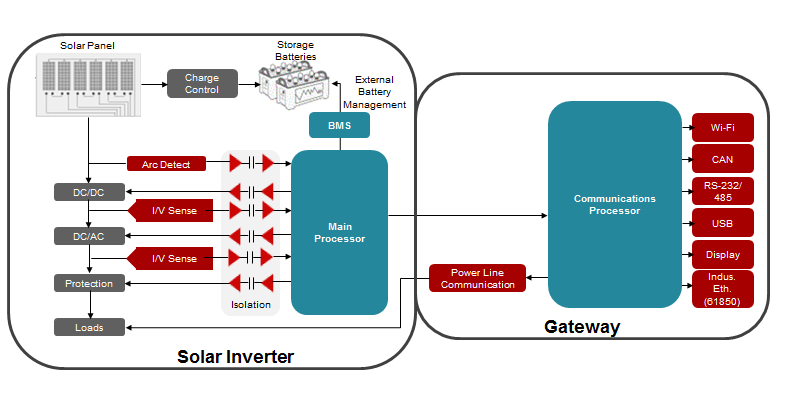Solar is one of the more popular forms of renewable energy, and continues to grow in both commercial and home use. Its popularity is driven in part by solar panels becoming increasingly cheaper, which has made systems affordable not only for commercial solar farms, but also for homeowners who want to lower their carbon footprint or even sell generated energy back to the grid, where possible.
Global Solar PV Capacity from 2004 to 2013. Source: REN21 2014, Renewables 2014 Global Status Report
While strides have been made in the past few decades to decrease the cost of solar panels, advancements are still being made in how generated energy is monitored and how information about it is communicated to the grid and to the owner of the system. These advancements affect the solar inverter, which converts the DC power generated by the solar panels into AC power, and the associated communication equipment such as solar inverter gateways, which are responsible for conveying information about the power generated and the solar panels themselves to owners, utilities, and grid automation systems.
After the solar inverter has converted the power and completed measurements the data from the inverter is transferred to the solar inverter gateway, which is responsible for analysis of the information as well as communicating with multiple end systems, each over its own interface and communication protocol. Information about energy generation, efficiency, and system health may be transmitted over Wi-Fi or Ethernet to web-based products provided by inverter manufacturers for monitoring of systems. Communication over RS-485 (Modbus)or CAN allows the solar inverter gateway to connect to the inverters themselves or to the larger system for plant communications in a commercial setting, and can also be used to connect to third party systems such as power meters if needed. Power Line Communication may also be used to connect the inverters or micro-inverters to the gateway, and has the advantage of not needing additional wiring or wireless configuration. Many solar inverter gateway products also include a display so that simple data can be read at the unit.
Solar Inverter and Solar Inverter Gateway System Block Diagram
In addition to all of the communication required to connect the inverter system with the grid and with plant controls, the solar inverter gateway also communicates with the owner of the system. Often this communication is accomplished through web-based portals and tools provided by the solar inverter manufacturer that supply visual and flexible interfaces for communicating energy harvest and yield, as well as service alerts. This can help a homeowner track their energy generation and consumption and increase consciousness of their energy habits, or can help commercial installations increase their overall efficiency by using sophisticated data reporting, such as output reports for each solar panel over time.
Solar inverter gateways have an important role to play in solar energy systems since they are constantly communicating with many different systems over many different peripherals. Processors in these systems need to have a wide range of peripherals and enough performance to run the various communication protocol stacks needed such as TCP/IP, or, in the future, IEC61850 for interoperability with the power grid- something that’s being considered by California’s Public Utilities Commission. TI’s AM335x Sitara ARM processor fits the bill with a Cortex-A8 processor and support for all interfaces commonly used in solar inverter gateways: two ports of Gigabit Ethernet, USB, two CAN interfaces, display, and six UART interfaces which can be used for RS485. And, a feature that’s important for any smart energy application, the AM335x is power efficient and can achieve total power consumption below 1W, with deep sleep as low as 3mW.
Solar inverter gateways can range from simple communication devices connected to a single inverter, to gateways connecting to up to 600 micro-inverters. AM335x offers a scalable solution with options that range from 300MHz to 1GHz. For even further processing power, the Sitara line extends to the AM437x which features an ARM Cortex-A9 core at 1GHz which is supported with the same Linux-based software package as AM335x for a seamless software transition between devices.
Perhaps the best feature of the AM335x, and one that has led to its popularity and success, is that it is easy to get started working with, with a variety of tools and many existing software examples. Get started today with the full-featured AM335x Starter Kit to access all peripherals needed for your solar inverter gateway design!


